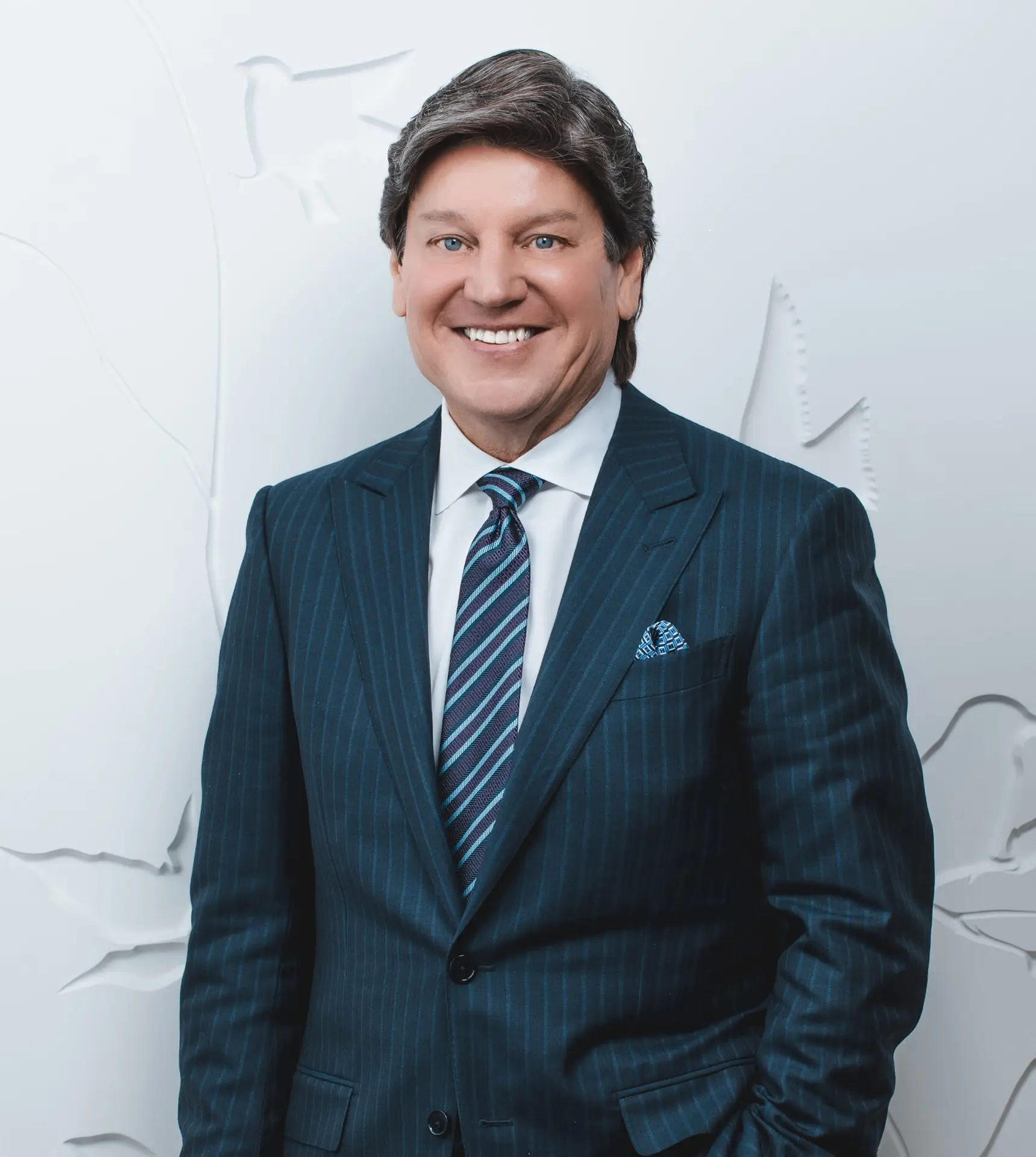30+ Years of Experience
3k+ Real Patient Reviews
10,000+ Breast Surgeries Performed
Texas Super Doctor
Breast Augmentation
in Houston
Dr. Paul Vitenas is a leading breast augmentation specialist in Houston, TX, who tailors his approach to each woman’s unique aesthetic goals. With over 35 years of experience and more than 500 breast augmentation procedures performed annually, he is renowned for achieving natural-looking results. Dr. Vitenas’s commitment to personalized care ensures safe procedures and boosts patients’ confidence through exceptional, individualized treatment.
4.9 (847 Reviews)
VIP Consultation
Discover why patients from across the U.S. and around the world choose Dr. Vitenas as the premier surgeon for naturally-appearing breasts.
What is Breast Augmentation?
Breast augmentation is cosmetic breast surgery that uses saline or silicone implants to enlarge the breasts and improve their shape and projection. In this procedure, the plastic surgeon makes incisions to create pockets for the implants, either under the breast tissue or the pectoral muscle. The implants are inserted into the pockets and positioned to achieve optimal, natural-looking results.

Breast Augmentation Before & After Photos





Reasons for Breast Augmentation
Increasing naturally small breasts
Regaining volume after pregnancy
Aging changes
Asymmetry correction
Breasts that are noticeably different sizes or shapes can be balanced and symmetrical through the implant procedure.
Improving proportions after weight loss
Gender affirmation
What are the Benefits of Breast Implants?
Breast implants offers many benefits that can positively impact aspects of your life.
- Larger Breast Size and Enhanced Curves: ENjoy a more voluptuous figure that beautifully complements your body.
- Improved Breast Symmetry: Achieve a balanced, symmetrycal look that enhances your natural shape.
- Fuller, Perkier Breast Shape: Experience a youthful and lifted appearance.
- Better projection and Cleavage: Enhance the ovarall shape and projection of your breast for a more striking silhouette.
- Proportions in Harmony with your Body: Create a more balanced and proportionate look that aligns with your body's natural contours.
- Confidence in Clothing and Swimsuits: Feel more confident and attractive in variety of outfits, from casual wear to swimwear.
- Renewed Self-Esteem and Positive Body Image: Boost your self-confidence and body image, leading to a happier and more fulfilling life.
Many of Dr. Vitenas’ patients share that their breast augmentation has significantly boosted their confidence and self-esteem, making them feel more comfortable and satisfied with their appearance. Dr. Vitenas tailors each procedure to the individual, ensuring results that enhance your natural body shape and meet your specific aesthetic goals.
Whether you’re seeking a curvier, sexier, more voluptuous figure or simply want to feel more confident in your own skin, the benefits of breast augmentation can be truly life-changing.
Candidates for Breast Augmentation
- Are physically healthy
- Have breasts that are fully developed
- Have realistic goals for enhancement
- Do not smoke or are willing to quit smoking
- Are not currently pregnant or breastfeeding
Women hoping to get pregnant or breastfeed in the future can still be good candidates. Be sure to address these topics with your plastic surgeon during your consultation.
Depending on the type of implants chosen, the minimum age requirement for saline implants is 18 years old, while for silicone implants, it is 22 years old.
The best way to determine if you are a candidate is to schedule an in-person consultation with Dr. Vitenas, a board-certified plastic surgeon who will evaluate your health, examine your breasts, and help you determine whether implants can achieve your cosmetic goals.
Kristen’s Breast Augmentation Testimonial
Silicone Breast Implants
at Vitenas Cosmetic Surgery
- Natural Feel: Silicone implants closely mimic the feel of natural breast tissue and have a softer, more natural feel compared to saline.
- Realistic Appearance: Silicone implants provide a more realistic slope, shape, and movement of breasts.
- Reduced Wrinkling: They are less likely to wrinkle or ripple than saline, especially for women with minimal breast tissue.
- Variety: Available in a variety of profiles, shapes, and textures to optimize your appearance.
- Age Approval: Women who are 22 years of age and older are approved for silicone implants in breast augmentation.
- Long-Lasting Shape: Silicone implants may be better able to maintain shape and fullness in the upper portion over time.
Dr. Vitenas will help you determine which silicone breast implants are right for you based on your body type, breast characteristics, and cosmetic goals. He employs advanced techniques to minimize the risk of complications and enhance outcomes
Your Boob Job Consultation With Dr. Vitenas
- Come prepared to discuss your goals for breast enlargement and any particular hopes you have for your results.
- Share information about your overall health, medications, and any pertinent medical history. Be candid about any health concerns, past or present.
- Ask any questions you may have about the procedure, potential risks, and what to expect during recovery.
- Take notes so you remember the details of your surgical plan, implant suggestions, recovery instructions, and any next steps to schedule surgery.
- View before and after photos to get an idea of potential results you may achieve from breast augmentation.
- Be prepared to discover new information about breast augmentation.
At your consultation, Dr. Vitenas will:
- Evaluate your health and determine if you are a good surgical candidate.
- Perform a physical exam of your breasts and take measurements.
- Recommend incision placement and position of the implants.
- Answer any questions and address any concerns thoroughly.
- Explain all aspects of the procedure, from your preparation through recovery.
- Provide information about costs, financing, timing, and scheduling surgery.
Dr. Vitenas will thoroughly discuss your implant options and make recommendations about the size, shape, filler material, and breast implant placement that will help you achieve your goals.
The right implants for you depend on the following:
- Your current breast size and amount of natural tissue
- Dimensions of your chest and width of the implant base
- The volume enhancement desired
- The look and feel you hope to attain
- Your lifestyle (active, athletic, etc.)
- Your body type and frame size
Boob Job Procedure Details
- General anesthesia is administered to keep you comfortable throughout the procedure.
- Incisions are made based on the pre-determined plan and will depend on the implant and the technique used.
- Implant pockets are carefully created above or underneath the chest muscle.
- Breast implants are inserted into the implant pockets and properly positioned.
- Incisions are closed with layered sutures, tape, or medical adhesives.
Pre-Op Care:
- Medical Evaluation: Complete any required medical evaluations or lab tests.
- Medications: Follow instructions on medications to avoid before surgery.
- Lifestyle Adjustments: Stop smoking and avoid anti-inflammatory drugs to reduce bleeding risk.
- Preparation: Arrange for transportation and post-surgery care.
Post-Op Care:
- Immediate Care: Rest and follow specific guidelines for caring for the surgical site.
- Medications: Take prescribed pain medications and antibiotics to prevent infection.
- Activity Restrictions: Avoid strenuous activities and follow the recommended timeline for resuming normal activities.
- Follow-Up Appointments: Attend all scheduled follow-up appointments for proper monitoring and recovery guidance.
Recovery & Results After Boob Job
Allowing time for your surgical incisions to close and the implants to settle into the intended position is part of the breast augmentation recovery process. Be sure to follow all post-op instructions carefully, including having a recovery kit and taking all medications as directed.
Boob Job Recovery
- Rest for the first 24-48 hours after your breast augmentation. Have someone available to assist you.
- Dr. Vitenas will instruct you to go braless for a period of time after the surgery.
- Expect some swelling, bruising, numbness, and mild discomfort. This is normal and subsides with time.
- Avoid taking blood thinners and salty foods for 6 weeks.
- Most patients can resume light activity or work 1-2 days after surgery.
- Wait 6 weeks before resuming any strenuous exercise.
- Attend follow-up appointments with Dr. Vitenas to monitor your progress.
Call the office promptly about severe pain, excessive swelling, discharge, fever, or other concerns. The risk of hematoma after breast augmentation, though rare, is a potential complication you might encounter.
Hematomas, which are collections of blood outside of blood vessels, can occur due to trauma or bleeding from the incision site. Symptoms include significant swelling, bruising, and pain. Early recognition and treatment are crucial to prevent further complications. Dr. Vitenas’ meticulous surgical techniques significantly reduce the likelihood of hematomas, but it’s important to be aware of the signs and seek immediate medical attention if they occur.
Boob job Results

You will get a preview of your breast augmentation results right after surgery. However, it will take weeks to months to appreciate the final outcome. Initially, you may notice that the results appear high and tight due to swelling and the effects of surgical compression.
Over time, the incision lines will fade, maturing into thin white scar lines, a process that typically takes twelve months. As the breast pockets stretch to accommodate the implants, mild shifting or settling of the implants is entirely normal. Also, while the sensation typically returns within a couple of months after the procedure, some degree of numbness may persist in the long term.
Patience is needed to allow complete healing and all swelling to resolve. Most patients take a few months for swelling to fully resolve so that they can see the beautiful, proportional breast contour they desired from surgery.
Breast Augmentation Cost
The price of breast augmentation varies significantly and is influenced by several aspects, such as the choice of your surgeon, the kind of implants you opt for, what other procedures you are combining the augmentation with, and the facility where the surgery takes place. During your consultation, Dr. Vitenas will discuss your specific needs and goals to provide a detailed quote for your procedure.
This approach ensures that you receive a personalized estimate that reflects your implant choices and any unique requirements of your procedure. On average, the cost of a primary breast implant surgery is around $7,000. Financing options are offered to make this sought-after procedure more accessible and budget-friendly.


Why Choose Dr. Vitenas
For Your Houston Breast Augmentation?
Dr. Paul Vitenas is board-certified in plastic surgery with over 35 years of experience and has performed more than 10,000 breast surgeries, making him a leading breast augmentation expert.
- Extensive Training: Graduated from Tulane University Medical School with fellowships in Miami and Paris.
- Innovative Techniques: Utilizes advanced methods to minimize contact with implants and employs post-surgical breast implant exercises to reduce capsular contracture risk.
- Unique Approach: Offers fat transfer breast augmentation for subtle enhancements using the patient’s own fat.
- Awards: Recognized as one of America’s Top Plastic Surgeons, Texas Super Doctor, and RealSelf Top Doctor for Breast Implants.
- State-of-the-Art Facility: Operates in a 15,000 sq ft accredited surgical center with the latest technology.
- Compassionate Care: Known for his caring demeanor, Dr. Vitenas listens to each patient’s unique goals, ensuring an exceptional experience from consultation to results.
By choosing Dr. Vitenas, you are assured of a dedicated practitioner committed to achieving your aesthetic goals with a relentless pursuit of perfection.
Breast AugmentationFAQ
It takes about 6-8 weeks for breast implants to fully heal and settle into place. Swelling gradually resolves over the first 2-3 weeks. Incision sites continue maturing for twelve months after surgery, with the scar gradually softening, becoming flatter, and changing colors.
After your breast augmentation surgery, Dr. Vitenas recommends sleeping on your back with your head and shoulders slightly elevated for 1-2 days. This reduces discomfort and swelling.
Preparation includes avoiding certain medications, stopping smoking, and following specific pre-operative instructions provided by your surgeon.
Some pain and discomfort occur during the first few days after surgery and can be managed with prescription medication; however, many people take only Tylenol. As you heal over the first two weeks, swelling and tightness will subside, and any pain gradually diminishes. Contact Dr Vitenas if you feel constant and sharp pain after breast augmentation or sudden onset of swelling accompanied by pain or discomfort.
Tightness and swelling after breast implant surgery peak at 3-5 days and slowly improve over the following weeks or months, depending on the size of the implant chosen (large or extra large breast implants also influence recovery), the tightness of the muscle and the degree of skin laxity or lack thereof. The remaining swelling typically resolves within a few months after your breast augmentation procedure.
Dr. Vitenas suggests that his breast augmentation patients not wear a bra for at least six weeks after surgery to allow their implants to move in the pockets while a lining forms around the pocket. This allows the breasts to settle into a natural look while keeping them soft, supple, and freely movable, as natural breasts are.
Choosing a qualified surgeon with extensive experience who will select and perform the proper implant placement will help avoid this problem. Dr. Vitenas also suggests mobilization techniques, which help keep the implant pocket open and minimize scar tissue formation.
On average, the cost of a primary breast implant surgery is around $7,000. The cost of breast augmentation varies due to different factors such as the the kind of implants used, and the charges of the surgical facility. Dr. Vitenas will discuss your specific needs and goals to provide a detailed quote for your procedure. This approach ensures that you receive a personalized estimate that reflects your implant choices and any unique requirements of your procedure. Financing options are offered to make this sought-after procedure more accessible and budget-friendly.
Dr. Paul Vitenas, with over 35 years of experience and more than 10,000 breast surgeries performed, is highly regarded as one of the top board-certified plastic surgeons in Texas. His extensive expertise and dedication to achieving aesthetically pleasing, natural results make him a premier choice for breast surgery in Texas and throughout the United States.
Breast implants typically begin to settle into their final position six weeks after surgery, although they might still appear slightly high or firm, depending on the patient’s initial condition and the size of the implants used. Any initial swelling has usually decreased significantly by this time, revealing a more natural contour. However, it may take several months for the implants to settle completely.
Breast augmentation with silicone gel implants is renowned for its ability to create a very natural look and feel. Dr. Vitenas provides many implant options designed to suit different body types and aesthetic goals. He specializes in advanced techniques that place the implant beneath the muscle, enhancing its natural movement with the body and promoting a more seamless and integrated appearance.
Gummy bear breast implants, offered by premium brands such as Natrelle, are form-stable, meaning that they maintain their shape even if the shell is compromised. Constructed from a highly cohesive silicone gel, these implants mimic the natural feel of breast tissue closely and are more durable than traditional silicone implants. The gel inside has some give when pressed but holds its shape in any position, reducing the occurrence of wrinkles or folds. The benefits of using highly cohesive silicone implants include a lower risk of capsular contracture, less rippling, and the ability to maintain shape without being deformed by gravity. Furthermore, early studies indicate a reduced incidence of leakage rates. Dr. Paul Vitenas is celebrated as one of the leading providers of these high-quality implants in the nation.
The longevity of breast augmentation can vary, but implants typically last 10 to 20 years. However, factors such as age, lifestyle, and changes in weight can influence the duration for which the results remain optimal. Breast Augmentation should not be considered a “one-and-done” procedure.
Implants usually begin to "drop" or settle into a more natural position within 3 to 6 weeks after surgery. This process can be quicker or slower depending on the individual’s body and the specifics of the surgical technique used.
Choosing the best surgeon involves researching their certifications, reviewing before and after photos of their work, and considering their experience, especially in breast procedures. Dr. Vitenas is a board-certified plastic surgeon and has decades of experience performing over ten thousand breast surgeries. His extensive portfolio of before and after photos and positive patient testimonials make him a standout choice for those seeking top-quality breast augmentation.
It's generally safe to start swimming again once all incisions are fully healed and there’s no risk of infection, typically about 6 to 8 weeks post-surgery.
Silicone gel implants are often preferred for their softer, more natural feel, whereas saline implants are chosen if patients are not comfortable with using silicone implants. Saline implants are approximately 30% heavier by weight than the same size silicone implant. Also, Saline, or salt water, is composed of water with salt added to it to make it compatible with our bodies. Water is a noncompressible substance, so when you squeeze a saline implant, you are only compressing the silicone elastomer shell that holds the saline. This is why when hugging someone with saline implants, the breasts feel harder and less natural than with silicone implants.
It's common for patients to notice some changes in nipple sensitivity following breast augmentation, but these alterations are usually temporary. Patients may experience less sensation in their nipples or more sensation after surgery. Especially if a patient has very sensitive nipples before surgery, they often become hypersensitive for six weeks to three months, then gradually go back to normal. It is possible to lose sensation in one or both nipples from breast augmentation surgery. This is more common in patients getting very large implants requiring the nerve to be stretched farther around the implant. However, it can also happen if a patient has an unusual anatomy. When performed by an expert like Dr. Vitenas, the procedure is carefully crafted to minimize any long-term sensitivity issues, ensuring that any changes in feeling or sensation are likely to gradually return to normal as you heal.
The right size depends on your body frame, existing breast tissue, and your desired outcome. Dr. Vitenas can help you choose a size that complements your overall body shape and meets your aesthetic goals. He will do this by first listening to you and your wishes, then suggesting sizes that fulfill that request, and finally by letting you try on actual implants of different sizes and shapes to allow you to see the differences and make an informed choice. This occurs during the consultation, and he provides his guidance and experience to every breast augmentation patient.
Breast implants vary in weight depending on their size, typically ranging from about 5 ounces (for smaller implants) up to about 14 ounces (for larger sizes).
Breast implants are designed to feel similar to natural breast tissue. Silicone implants, in particular, tend to have a softer and more natural feel compared to saline options.

